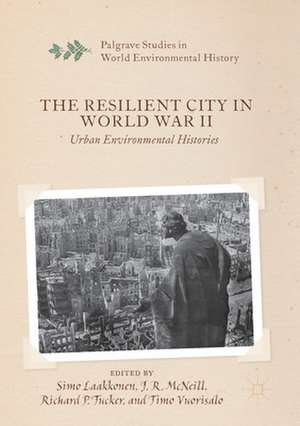The Resilient City in World War II: Urban Environmental Histories: Palgrave Studies in World Environmental History
Editat de Simo Laakkonen, J. R. McNeill, Richard P. Tucker, Timo Vuorisaloen Limba Engleză Paperback – 14 aug 2020
| Toate formatele și edițiile | Preț | Express |
|---|---|---|
| Paperback (1) | 690.32 lei 17-23 zile | +68.43 lei 7-11 zile |
| Springer International Publishing – 14 aug 2020 | 690.32 lei 17-23 zile | +68.43 lei 7-11 zile |
| Hardback (1) | 736.50 lei 6-8 săpt. | |
| Springer International Publishing – 7 iun 2019 | 736.50 lei 6-8 săpt. |
Preț: 690.32 lei
Preț vechi: 758.59 lei
-9% Nou
Puncte Express: 1035
Preț estimativ în valută:
132.11€ • 143.45$ • 110.97£
132.11€ • 143.45$ • 110.97£
Carte disponibilă
Livrare economică 28 martie-03 aprilie
Livrare express 18-22 martie pentru 78.42 lei
Preluare comenzi: 021 569.72.76
Specificații
ISBN-13: 9783030174415
ISBN-10: 3030174417
Pagini: 317
Ilustrații: XX, 317 p. 31 illus., 12 illus. in color.
Dimensiuni: 148 x 210 mm
Greutate: 0.44 kg
Ediția:1st ed. 2019
Editura: Springer International Publishing
Colecția Palgrave Macmillan
Seria Palgrave Studies in World Environmental History
Locul publicării:Cham, Switzerland
ISBN-10: 3030174417
Pagini: 317
Ilustrații: XX, 317 p. 31 illus., 12 illus. in color.
Dimensiuni: 148 x 210 mm
Greutate: 0.44 kg
Ediția:1st ed. 2019
Editura: Springer International Publishing
Colecția Palgrave Macmillan
Seria Palgrave Studies in World Environmental History
Locul publicării:Cham, Switzerland
Cuprins
I. Introduction.- 1. Environmental History, the Second World War, and Urban Resilience.- II. Urban Environment.- 2. Critical Networks.- 3. Fortress City: The Militarized Landscape of Seattle.- 4. War and Urban-Industrial Air Pollution in the UK and US.- 5. Imagined Resilience.- III. Urban Nature.- 6. Guerrilla Gardening? Urban Agriculture and the Environment.- 7. Gaining Strength from Nature.- 8. Resilience behind Bars.- 9. Where Have all the Pigeons Gone.- IV. Urban Society.- 10. Partial Resilience in Nationalist China's Wartime Capital.- 11. Japanese-Occupied Hanoi.- 12. The Esteros and Manila’s Postwar Remaking.- 13. Apocalyptic Urban Future.- V. Conclusions.- 14. Epilogue: What Makes a City Resilient?
Notă biografică
Simo Laakkonen is Senior Lecturer of Landscape Studies at the University of Turku, Finland.
J. R. McNeill is Professor of History at Georgetown University, USA.
Richard P. Tucker is Adjunct Professor of Environmental History at the University of Michigan, USA.
Textul de pe ultima copertă
The fate of towns and cities stands at the center of the environmental history of World War II. Broad swaths of cityscapes were destroyed by the bombing of targets such as transport hubs, electrical grids, and industrial districts, and across Europe, Asia, and the Americas, urban environments were transformed by the massive mobilization of human and natural resources to support the conflict. But at the same time, the war saw remarkable resilience among the human and non-human residents of cities. Foregrounding the concept of urban resilience, this collection uncovers the creative survival strategies that city-dwellers of all kinds turned to in the midst of environmental devastation. As the first major study at the intersection of environmental, urban, and military history, The Resilient City in World War II lays the groundwork for an improved understanding of rapid change in urban environments, and how societies may adapt.
Caracteristici
Offers the first in-depth investigation of the relationship between World War II, cities, and the environment Covers a diverse array of socio-geographical environments across four continents Argues for the relevance of the urban environmental history of World War II today, as the consequences of climate change loom large and compel cities to find new solutions













